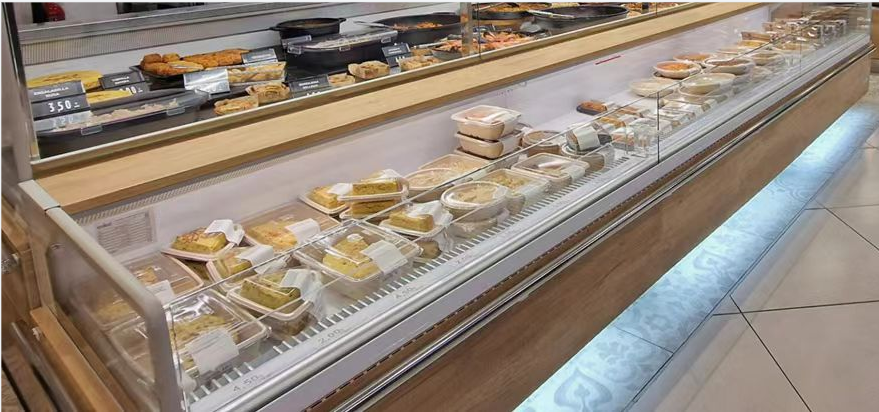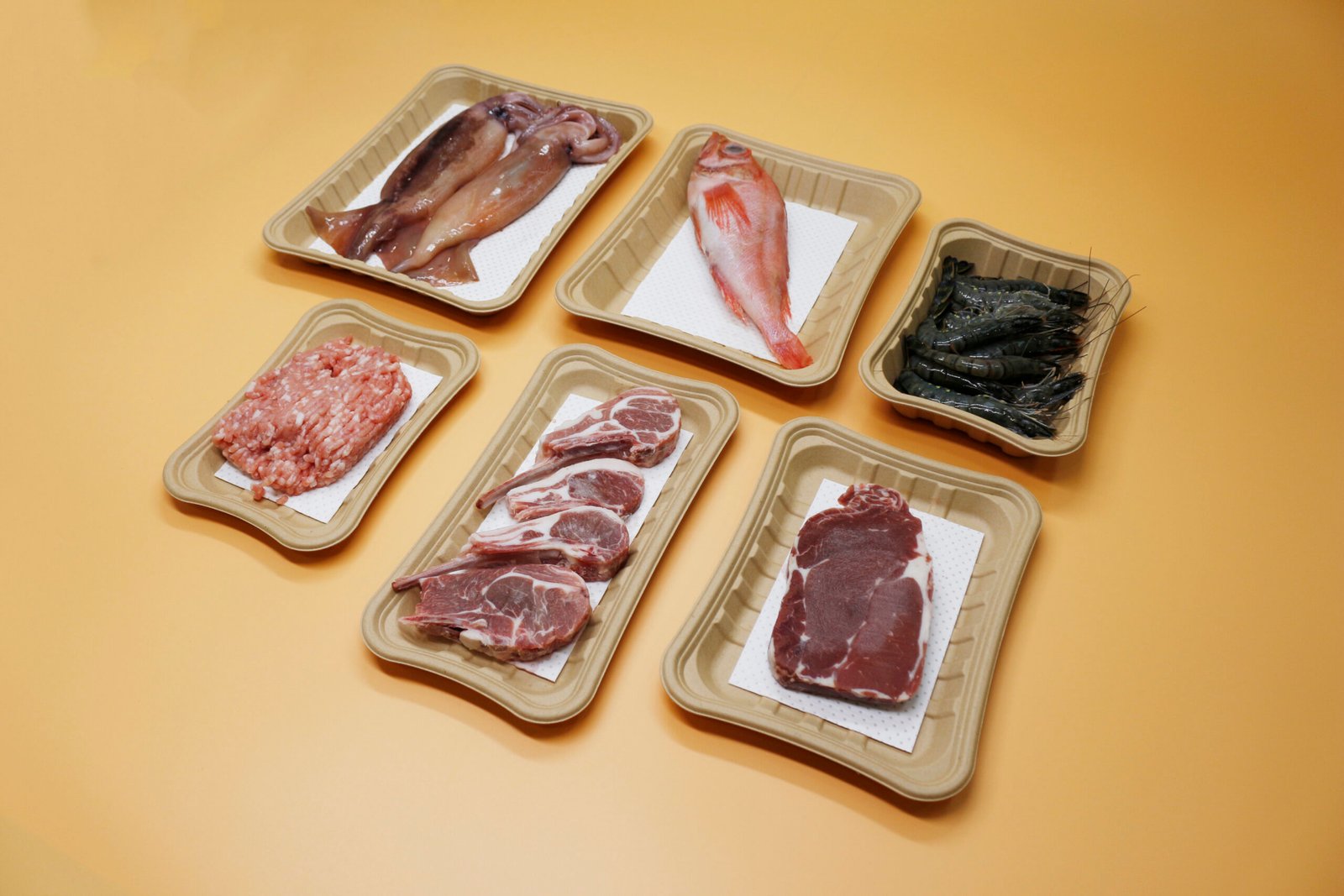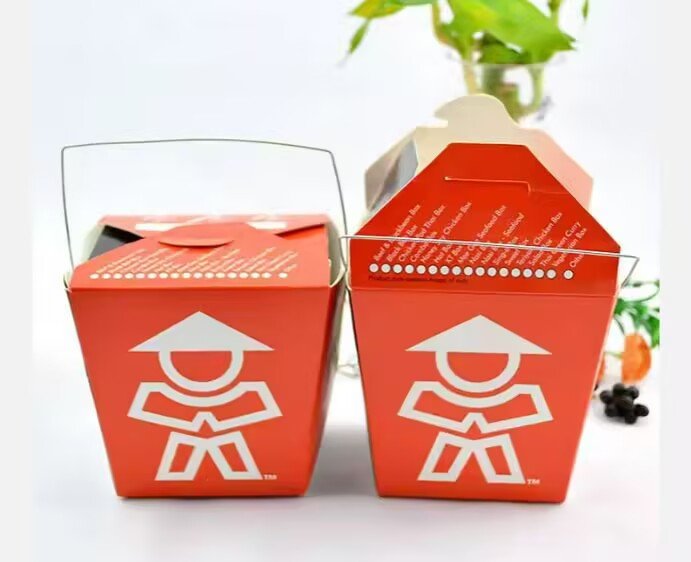Plastic ban and solutions in European supermarkets by 2025 (4)
Ganyuan
2025 年 4 月 30 日

In an era where over 300 million tons of plastic are produced globally each year, with a significant amount flowing into the oceans and landfills, companies are facing unprecedented environmental responsibilities. The food industry, as a major consumer of plastics, from food trucks to high-end restaurants, from bakeries to vegetarian eateries, every delivery and dine-in order hides the challenge of sustainable packaging materials. In this green transformation, “custom plant fiber pallets” are becoming a key solution for food companies to achieve their “plastic-free goals,” thanks to their unique environmental attributes and flexible design.
1.Why plant fiber pallets are the core choice for eco-friendly packaging?
Traditional packaging materials, such as foam plastics and petroleum-based products, have become major drivers of the global waste crisis due to their non-biodegradability and high pollution. Studies show that disposable plastic cutlery alone generates over 8 million tons of waste annually, with only 9% being recycled, leaving the rest to linger in the natural environment for long periods. Plant fiber trays, especially customized products made from renewable resources like bamboo pulp, sugarcane bagasse, and wheat straw, are revolutionizing this situation. Their core advantages are reflected in the following aspects:
1. Reduce environmental burden at source
Plant fiber pallets are made from agricultural waste or fast-growing plants (such as bamboo), not only reducing reliance on forest resources but also converting “waste” into high-value products through recycling. For example, the production process of bamboo pulp fiber pallets emits 60% less carbon than traditional plastics and can fully decompose in just 3 to 6 months under commercial composting conditions, completely avoiding the issue of plastic pollution that remains “indestructible for millennia.”
2. Customized design to meet diverse needs
The packaging needs of food companies vary widely: bakeries require oil and moisture-resistant trays to hold pastries, hot pot takeout requires containers that can withstand high temperatures for soup bases, while high-end dining seeks minimalist and aesthetically pleasing plating designs. “Custom plant fiber trays” can be flexibly adapted to different scenarios by adjusting fiber ratios, surface coating techniques (such as food-grade PLA waterproof film), and mold design. For example, trays designed for cold drinks enhance anti-condensation performance, while those customized for hot meals can withstand temperatures up to 120℃ without deforming.
3. Enhance brand value and customer loyalty
As consumer environmental awareness grows, 73% of Generation Z prefer brands that use sustainable packaging. Custom pallets not only feature the company’s LOGO and eco-friendly slogans but also convey a “green commitment” through the natural texture of the material. For example, after a chain coffee brand switched to bamboo fiber cups, customer repurchase rates increased by 20%, and social media mentions of “eco-friendly packaging” rose by 35%.
4. Win-win between policy compliance and cost optimization
Many countries around the world have enacted plastic restriction regulations, such as the EU’s ban on single-use plastic cutlery and China’s “14th Five-Year Plan” which explicitly requires reducing plastic waste. Companies that adopt plant fiber pallets in advance can not only avoid policy risks but also reduce packaging costs through bulk procurement and long-term use. For example, bamboo fiber pallets, though slightly more expensive than conventional plastics, incur 40% lower composting fees compared to plastic recycling and are eligible for tax incentives in some regions.
2. Application scenarios and innovative cases of plant fiber pallets
The flexibility of plant fiber pallets makes them stand out in multiple scenarios in the food industry:
1. Take-out and fast food: safety and convenience are equally important
Traditional plastic food containers are prone to oil seepage and deformation, whereas custom-made plant fiber trays can enhance structural design to achieve leak-proof and pressure-resistant functions. For instance, a Southeast Asian fast-food brand used a sugarcane fiber tray to serve curry meals, with its dual-layer freshness-locking design extending delivery time by 2 hours and reducing customer complaints by 50%.
2. Baking and dessert: the integration of aesthetics and function
The natural texture and matte texture of bamboo fiber trays highlight the sophistication of baked goods. A high-end bakery in Germany has customized a stackable straw fiber tray, which not only saves storage space, but also attracts a large number of environmentalists with its “zero plastic” label.
3. Fresh and cold chain: a durable green option
By adding natural moisture-proof agents (such as corn starch coatings), plant fiber trays can withstand the low temperatures and humidity during cold chain transportation. An organic supermarket in New Zealand uses custom bamboo pulp trays to package fruits and vegetables, extending shelf life by 15%, and the trays can be composted directly with food waste, achieving a closed loop from “farm to soil.”
4. Large-scale activities and aviation catering: a model of scale reduction of plastic
Large events and airline catering services need to deal with thousands of meals at a time. After replacing plastic meal boxes on board with bamboo fiber trays, an international airline reduced its plastic use by 80 tons per year, won an industry award for its environmental initiatives, and greatly improved its brand image.

3.How to achieve the customized transformation of plant fiber pallet efficiently?
Kurz vor dem Inkrafttreten der EU-PPWR-Verordnung schreiben die Geschenkboxen aus Bambuszellstoff, die wir für spanische Weinhändler individuell gestaltet haben, die Spielregeln für hochwertige Verpackungen neu. Die Kombination aus lasergravierter Bambusstruktur und biologisch abbaubarer Sojatinte reduziert die Verpackungskosten um 35 % und erhöht gleichzeitig die Attraktivität des Produkts im Regal um 200 %. Interessanterweise sind die Recyclinganweisungen für diese Verpackungscharge auf Chinesisch, Kyrillisch und Arabisch verfasst – dies ist eine anschauliche Fußnote zur globalen grünen Lieferkette.
Noch aufschlussreicher sind die Daten vom nordamerikanischen Markt: Walmarts Lieferantenplattform zeigt, dass die Anfragen nach Verpackungsprodukten aus Bambuszellstoff mit FSC-Zertifizierung im Vergleich zum Vorjahr um 340 % gestiegen sind. Zu diesem Zweck haben wir speziell eine Indoor-Kompostierungslösung entwickelt, die dem Standard ASTM D5338 entspricht. Kunden müssen lediglich den QR-Code auf der Verpackung scannen, um den Abbaufortschritt des Materials bei bestimmten Temperaturen und Luftfeuchtigkeiten anzuzeigen. Dieser transparente Rückverfolgbarkeitsmechanismus lindert die Bedenken ausländischer Käufer hinsichtlich des Risikos des „Greenwashing“.
4. Zukunftsformel: Grüne Entkopplung von Smart Manufacturing
For food companies, the transition from traditional packaging to custom plant fiber pallets requires systematic planning. Here are four key steps:
1. Requirements analysis and prototype design
Deep communication with suppliers to clarify usage scenarios (such as temperature resistance, load-bearing capacity), design styles (such as color, texture), and cost budgets. It is recommended to start with small-scale trial production to optimize details through actual testing. For example, a pizza chain tried three different tray thicknesses and ultimately selected the version with a 15% higher edge, which solved the cheese overflow issue.
2.Supply chain and certification control selection
Suppliers certified by FSC (Forest Management Council) and BPI (Biodegradable certification) ensure that the raw materials are legally sourced and the production process is low carbon. At the same time, it is necessary to confirm whether there are supporting composting facilities in the local area to avoid the embarrassment of “degradable but nowhere to be disposed”.
3. Consumer education and marketing linkage
The value of transformation is communicated to consumers through environmental labels on packaging, popular science videos on social media, and even composting experiments displayed in stores. For example, a coffee shop in the United States printed a QR code at the bottom of a tray, which can be scanned to view the full life cycle carbon footprint of the tray from bamboo to compost, prompting customers to spread it spontaneously.
4. Continuous iteration and feedback optimization
Collect customer and employee feedback on a regular basis to improve the design according to the pain points. For example, when a Japanese food brand found that the pallet was easy to break during transportation, the supplier quickly adjusted the fiber mix ratio to increase the compressive strength by 30%.
5.Future outlook: The infinite potential of plant fiber pallets
As biobased material technology advances, plant fiber pallets are evolving towards lighter and smarter designs. For instance, RFID-tagged pallets can track carbon data in the food supply chain; versions with antibacterial coatings can further extend the shelf life of food. The global push for carbon neutrality will inevitably accelerate the adoption of this category —— it is estimated that by 2030, the plant fiber packaging market will exceed $100 billion.
For food enterprises, investing in customized plant fiber pallets is not only a fulfillment of environmental responsibility, but also a strategic choice to seize the future market. When every takeout package becomes a carrier of “plastic reduction action”, the green story of enterprises will also be deeply rooted in people’s hearts, and transformed into real brand premium and customer loyalty.
Conclusion:
From bamboo pulp to sugarcane bagasse, from standardization to personalization, custom plant fiber trays are redefining the possibilities of food packaging. They are not only a solution to replace plastic but also a medium for companies to convey their values to consumers. In this sustainable revolution, whoever can first integrate environmental concepts into product details will gain an advantage in future competition. And all of this begins with a simple choice: to ensure that every piece of food is served on eco-friendly trays.


